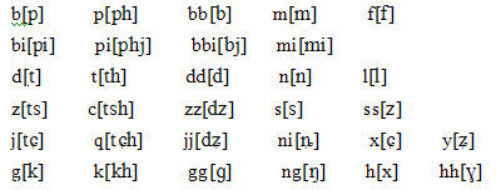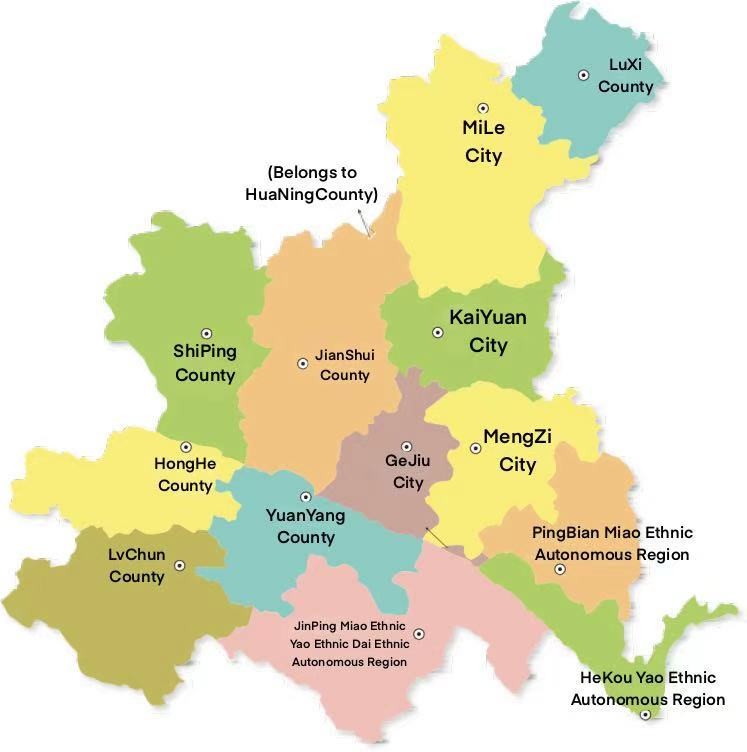

Hani Language
A Brief Overview

「Hani Language with Latin Phonetic Transcription」
The picture shown above is a "Latin phonetic transcription" system successfully designed by the government for the Hani people in 1947.
For Reference
The Hani people have no records in terms of their language, including a formal system for the language itself—there are no spelling rules, no grammatical framework, and no writing system.
For a long time, the transmission of the Hani language and culture has largely been attributed to the creation and preservation of epics. "Hani Apei Cong Popo" is one of the epics that is relatively systematic, complete, and of special significance. Its rich content presents the entire history of migration and evolution of the Hani people since around 483-475 BC.
In the late 1950s, after the founding of the People's Republic of China, the government began to intervene and created a Hani phonetic system based on the Latin alphabet for the Hani people[3]. The purpose of this move was to better enable the Hani language to be passed down in accordance with its current preserved state.Key Issues Concerning the Hani Language
Vulnerabilities and Discrepancies

According to Zhao (2023), the Hani language has long relied on oral transmission,without written records[3]. This pattern reflects the oral-centered cultural characteristics of the Hani people and also results in a high degree of flexibility in the phonological and grammatical structure of the language. Compared with other ethnic minorities, Hani has no fixed grammatical rules or spelling system, and belongs to an “informal language system”, with significant differences in language formation depending on the region and branch of the ethnic group. Because of this, with the promotion and popularization of Putonghua, the frequency of use of the Hani language has gradually declined, especially among the younger generation.

In the process of increasing social modernization, the Hani language is also undergoing corresponding self-adjustment and renewal. However, there is one point worthy of attention: although the Hani language now, with the help of the "Latin phonetic transcription" system, has a relatively prominent advantage in enabling more Hani people to use their mother tongue, Mandarin remains the primary language promoted and used in the education system of Hani-inhabited areas (such as the Honghe Hani and Yi Autonomous Prefecture in Yunnan). This is precisely the reason why the frequency of Hani language use is gradually decreasing.
The content shown in the picture above is the school emblem of LiHao Zhai Township Middle School in Jianshui County, Honghe Hani and Yi Autonomous Prefecture, Yunnan Province, which is written in Hani, Yi, and Chinese.
Environmental Aspects of Hani Language Use
1Dai Qingxia's preliminary research
In his research, he pointed out that the Hani people generally live in a bilingual or even multilingual environment. The Hani language is used within the ethnic group, while Chinese has become the main tool for inter-ethnic communication. The sinicization of school education and the reduced probability of using the mother tongue in family education have posed challenges to the intergenerational inheritance of the Hani language.
2Further explanation
The use of the Hani language in public domains is limited, and it is more often used in families and traditional rituals[2]. Additionally, the Hani language is not only a communication tool but also carries the Hani people's history, religion (rituals), and cultural identity.
3Conclusion
Zhao Dewen mentioned that the Bema (traditional religious figures of the Hani people) pass down religious rituals and culture through oral means, making the Hani language an important carrier of ethnic culture.

Deficiencies in the Range of Applications
Although the newly created writing system has, to a certain extent, filled the gap in written records, its practical application is still limited to specific fields such as education and literacy campaigns, failing to be widely used in daily life and remaining underdeveloped. Surveys in Honghe Prefecture show that the written form of the Hani language is mostly used in literacy education and basic education, while its application in fields such as literary creation and scientific communication is almost non-existent. Furthermore, the rapid advancement of globalization and modernization has further caused the usage environment of the Hani language to be replaced by Mandarin and other mainstream languages. Many Hani youth groups tend to acquire more educational and career opportunities through Mandarin and English, which has weakened their dependence on their mother tongue[2].
More Examples
Specifically within the scope of Lüchun County. Dai Qingxia and his team once visited here to conduct a local survey. One of the most notable tests among them was the mother tongue proficiency test for the Hani people. The results of this test ultimately showed that the group relatively unfamiliar with their mother tongue was limited to adolescents aged 6-19[5]. Compared with people of other age groups, the phenomenon of "having a slight understanding" or even "not knowing" their own mother tongue was most prevalent among adolescents aged 6-19.

However, there lies another important factor...
Among this group of adolescents aged 6-19, it is essential to note that there is a certain proportion of younger individuals within this age group. In other words, in this test, it is highly likely that a small number of adolescents encountered words they had never been exposed to at all (and perhaps even advanced vocabulary). Therefore, to further summarize and demonstrate this point in detail, Dai Qingxia's team also designed another set of test procedures.

Hani 400-Word Test
The difference between this language proficiency test and the previous one lies in a more detailed selection of words.
Subsequently, the test yielded some unprecedented data.
Dai Qingxia's research team found that some commonly used words were extremely unfamiliar to some adolescent groups—they did not recognize them at all. With this information, the researchers further reflected on and analyzed the phenomenon. They then discovered that the reason why adolescents were so unfamiliar with such words that seemed to appear frequently in daily life was that the actual occurrence frequency of these words in "real life" had decreased:For example, words like "thatch, cotton, sesame, crossbow, arrow"[5]—of course, in the context of modern society, the probability of their use and occurrence has become very low. Here, the probability of use and occurrence does not refer to the use of the words themselves, but rather that the objects represented by these words are rarely used in real life. Therefore, it is only natural that adolescents have no opportunity to learn these words and thus lose their understanding of them.
This is also indirectly related to the "defects in the scope of application" discussed earlier. With the progress and development of the times, the usage rate of many words that Hani people used to frequently employ in daily life has significantly declined.
The current situation of Hani language usage varies across different regions, with discrepancies resulting from local factors.
Objective Conditions
Protecting the Hani Language - Dynamic Inheritance
1High Degree of Concentration[5]
Lüchun County, the area studied by Dai Qingxia, is one of the counties with the highest concentration of ethnic minorities in China. Within the county, local Hani people can be seen communicating with each other in their mother tongue everywhere—the Hani language has become an important tool for daily and emotional communication among the Hani people in Lüchun County.
To better maintain the current usage rate of the Hani language and ensure its better inheritance, a key aspect is to increase the language's usage rate. This is why the daily usage rate and occurrence of the Hani language are relatively the highest in regions like Lüchun County.
2Emotional Support as a Foundation
The deep affection for their mother tongue is a crucial element in protecting the Hani language. To avoid stereotyping and confining the culture, we must also respect the thoughts and perceptions of local people.
The fact that the usage rate of the mother tongue is higher than in other regions also indirectly indicates that the Hani residents of Lüchun County are relatively more willing to use their own mother tongue to communicate with fellow ethnic group members. This makes them feel comfortable and also shortens the distance between people within the ethnic group[5].3Isolation Caused by Regional Immobility
Lüchun County is located in an area with rather inconvenient transportation. To a certain extent, this inconvenience has restricted the arrival of outsiders. This means that as the number of outsiders decreases, the inflow of foreign languages also diminishes. This phenomenon has enabled Lüchun County to successfully avoid excessive influence from foreign languages and better maintain the use of its own language within its controllable range.
4Cultural Protection
Finally, the most critical point, and also the core of our project: cultural protection. Additionally, we advocate for "dynamic inheritance." As mentioned earlier, we cannot protect a culture by fixing it in a state of "only living in the past." Culture also changes with the times—social environments will prompt culture to self-repair. A fatal mistake in cultural protection is treating it as an antique in a museum.
"Language is part of culture"[5]. Language and culture are synchronous. These two elements need to be cared for and protected simultaneously. This website has made significant contributions in this regard. The history, cuisine, clothing, art and music, and festivals of the Hani people, and even everything here—including the language—belong to the culture of the Hani people.
The emergence of language has driven the development of human civilization.
It is precisely because of the existence of different ethnic languages that the world becomes significant!
"The limits of my language mean the limits of my World."
References:
[1] 张素杰. 云南省哈尼族大学生语言使用及语言态度探析 [J]. 思茅师范高等专科学校学报, 2009, 25 (01): 105-107.
[2] 熊雯. 云南绿春县戈奎乡哈尼族语言使用现状调查研究[D]. 中央民族大学, 2018.
[3] CHINASTUDIES@UM.EDU.MY. Institute of China Studies [EB/OL]//Um.edu.my. (2023)[2024-12-11].
https://ics.um.edu.my/contemporary-china-studies-vol-10-no-1-april-2023.
[4]嘎汤帕节[EB/OL]//百度百科.(2024)[2024-12-12]. https://baike.baidu.com/item/%E5%98%8E%E6%B1%A4%E5%B8%95%E8%8A%82/6045668.
[5] 戴庆厦. 云南绿春县哈尼族语言使用现状及其演变[D]. 中央民族大学“985工程”中国少数民族语言文化教育与边疆史地研究创新基地文库,2012.
Contact us:
1206069@
All copyrights of this website belong to the "Cultivating Hani Lore" Project Team.
This website is produced by the "Cultivating Hani Lore" Project Team.






